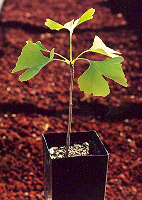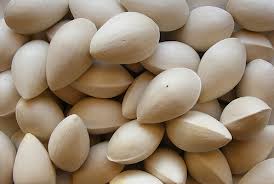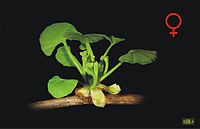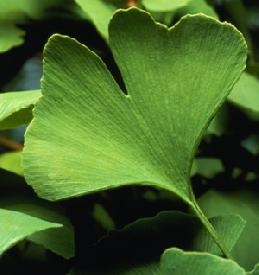Table of Contents
Ginkgo biloba
(Family: Ginkgoaceae)
Alias names for Ginkgo biloba: Smart Herb, The Living Fossil, GBE (Ginkgo Biloba Extract), Sacred Tree of the East, Bearer of Hope, The Coat Tree, Ginkgo, Maidenhair Tree, Yin Xing, Pinyin Romanization, Tree Hair of Venus, Bai-guo (seeds), Ginna (nut), Ginkyo
Ginkyo, its original name, was derived from the roots Gin = Silver and Kyo = Apricot. Possibly a clerical error changed its spelling? The Ginkgo tree is the only tree in this family it has been around for so long.
Pictures of Ginkgo biloba:
We purchase our seeds from Horizon Herbs. They also sell the seedlings (plant above) https://www.horizonherbs.com/product.asp?specific=1052
We purchased some Ginkgo seed (nuts) to plant in 2014 and they did look good enough to eat. Here’s a photo of the nuts (not the ones we purchased) They are about ½ inch in diameter and a bit rounder than a pistachio nut. Wikipedia has great photos of the male and female ginkgo trees (seen below): https://en.wikipedia.org/wiki/Ginkgo_biloba
About Ginkgo biloba:
Known as the Sacred Tree of the East, the Bearer of Hope, the ginkgo tree has been around for over 2 million years and has been traced back from fossils to the Permian period. Charles Darwin called it a living fossil. The leaves and nuts have been used in Chinese medicine for over 500 years.
The Chinese used the nuts for urinary complaints and used the leaves as tea to help memory disorders. It has been called the Bearer of Hope because only the ginkgo tree was left standing after Hiroshima and the Chernobyl incidents. Because brain cells contain a high percentage of unsaturated fatty acids in their membranes, they are very susceptible to free radical damage through oxidation. Active chemicals in ginkgo scavenge these free radicals making the cell membranes suppler so they can communicate better with one another. One study noted that even healthy people (students cramming for exams perhaps) have shown significantly improved test scores from taking this extract within an hour of taking their exam.
Vantage, Washington hosts the Ginkgo Petrified Forest State park which includes a museum featuring ginkgo trees. Watch out for rattlesnakes as you head down the path along the Columbia river: https://www.stateparks.com/ginkgo_petrified_forest.html
Historical Actions and Uses for Ginkgo biloba:
I had a stack of older research papers on ginkgo from when I first became interested in alternative medicine twenty years back which I read and highlighted to build this page before heading to the internet. It amazed me how each paper focused on some of ginkgo’s uses but did not mention others. It was quite the task to coordinate these historical uses for ginkgo. Here is it:
- Absentmindedness
- Alzheimer’s (early stages)
- Antioxidant (powerful)
- Anxiety
- Asthma
- Atherosclerosis
- Brain trauma
- Bronchitis
- Bronchoconstriction
- Cancer
- Cochlear deafness
- Confusion
- Coughs
- Decreases bloating related to menstrual cycle
- Decreases capillary permeability (so it helps with edema)
- Delays early mental deterioration
- Dementia
- Depression (mild)
- Eliminates some parasites (historical use)
- Given after kidney transplants
- Headaches, migraines
- Heals arteriopathy of the legs (severe pain when walking)
- Helps regulate hormones (serotonin, muscarinic and thyrotrophin releasing hormone)
- Hemorrhoids
- Immune system modulator
- Impotence from poor circulation
- Improves tolerance to hypoxia
- Improves vascular integrity
- Incontinence (the seeds)
- Increases alpha wave activity (slightly decreasing theta waves)
- Increases blood flow
- Increases microcirculation by decreasing blood viscosity, erythrocyte aggregating and leukocyte rigidity
- Increases peripheral circulation (therefore decreasing asthenia–the feeling of heaviness, weakness and numbness of the limbs)
- Increases physical performance
- Increases RBC flexibility and flow velocity
- Inhibits arteriolar spasm
- Inhibits (PAF) Platelet Activating Factor’s antagonistic affects
- Intermittent claudication
- Lack of energy
- Leg cramps
- Mild relaxing effect
- Modulates damage from LDL cholesterol
- Multiple sclerosis
- Nerve injury caused from chemotherapy
- Neuropathy from diabetes
- Pancreatitis
- Parkinson’s disease
- Protects the brain from hypoxia and edema
- Radiation induced injury (nerves)
- Raynaud’s disease
- Regenerates damaged nerve cells
- Regulates blood flow (with associated slight increase in body temperature) to the brain, head, skin, limbs and female breast areas
- Relieves muscle pain
- Repairs damaged nerves
- Reperfusion ischemia following renal transplant
- Restores vigilance (wakefulness, watchfulness, arousal)
- Senility (beginning)
- Short term memory loss
- Strengthens capillaries and connective tissue structures
- Stress
- Tinnitus
- Tiredness
- Tones the sympathetic nervous system
- Ulcers
- Used for sepsis syndrome where the body reacts with inflammation, circulatory problems and shock
- Vertigo
- Visual improvement: Improves diabetic retinopathy, retinal insufficiency and macular degeneration
Parts of Ginkgo biloba Plant Used:
Ginkgo is a bittersweet and astringent herb. The leaves are used as a standardized extract (called EGb761) which contains 24% ginkgo heterosides (flavone glycosides) and 6% terpene lactones. The 5-15 cm flat bi-lobed fan-shaped leaves are harvested in the fall after they turn a beautiful golden yellow. It takes 50 pounds of leaves to make one pound of extract! This process takes 27 steps and up to 2 weeks to accomplish. Most all the scientific studies (now well over 300 of them) in the last 30 years were done with standardized extract of Ginkgo but the seeds (nuts) and bark have also been used for various health issues for hundreds of years.
Chemical Constituents of Ginkgo biloba: Ginkgo contains some chemicals specific to ginkgo only. Ginkgo biloba leaf extract (EGB761) contains the active ingredients lactone derivatives (ginkgolides), ginkgo heterosides, bilobalides (also known as terpenes or terpene lactones) and flavonoids (flavonol and flavone glycosides). Ginkgo also contains 6-hydroxykinuretic acid, bioflavonoids, catechin, iron-based superoxide, isorhamnetin, kaempferol, protocatechuic acid, quercetin (also a component of onions), shikimic acid, sterols and vanillic acid.
Contraindications, safety issues, concerns, harmful drug interactions and allergy precautions for Ginkgo biloba:
Negative side effects from taking Ginkgo are rare but include mild headaches (which may last 2-3 days), gastrointestinal disturbances (stomach upset, nausea, diarrhea), skin hypersensitivity/ dermatitis (much like the blisters you get from poison ivy) and increased bleeding times.
I read on one pharmacy website that “the ginkgo seeds contain a potentially toxic substance, ginkgotoxin (4-O-methoxypyridoxine), which has anti-vitamin B6 activity and inhibits GABA formation, which can potentially lead to convulsions and loss of consciousness” but I don’t know how many seeds you would have to eat for this to happen. This seems strange since the seeds have been eaten as a food and as medicine (breathing problems and urinary incontinence) in China for thousands of years. You’d have thought they would have figured out this toxic symptom after all those thousands of years. Hmmm.
At least the person wouldn’t wet their pants while in convulsions, right? (Reference: https://www.clevelandclinicmeded.com/medicalpubs/pharmacy/sepoct02/ginkgo.htm) OK, I’m just funnin’ with you.
The antidote to toxic symptoms would be Vitamin B6. Harvest the seeds wearing gloves, roast them outdoors and don’t eat more than 5/day for safety reasons.
Seriously though, if you are on blood thinners, antiplatelet therapy, NSAIDS (which are also blood thinners) or MAO antidepressants you may want to check with your doctor or herbal practitioner before taking ginkgo. This herb is safe for pregnant and/or lactating women.
Cultivation of Ginkgo biloba:
Ginkgo biloba is a beautiful ornamental tree which grows up to 100 feet tall and 27 feet wide and living over 1000 years. It takes both a male and female plant to create the seeds (nuts) which are produced on the mature female tree. The male trees are more columnar and narrow. The females have a wider crown at the tree’s top. Ginkgo grows most prominently in the southern and eastern United States and was originally brought from China. Gingko is propagated via seed harvested in autumn or from softwood cuttings in the spring. It can also be propagated by side veneer grafting in the winter. I didn’t know what side veneer grafting was so I looked it up: https://grow.ars-informatica.ca/grow_topic.php?subject=gra4 I suspect they use this technique for reviving bonsai trees. The ginkgo is a popular bonsai plant.
Ginkgo likes fertile, heavy, moist, well-drained soil. Grow in full sun given ample room. I’ve read that this tree will die back if pruned and it does not like its roots disturbed so be gentle when you transplant the seedling. A horticulturist once told me not to plant a female ginkgo too close to the house because when it buds out in the spring it really stinks. I had to check this out of course so I googled it. One person said the unripe seeds smell like dog excrement or some kind of noxious, acidic pungent soft cheese. Great. I’m hoping to relate that as a personal experience from our food forest plantings at our home at Elk Meadow Farm & Nursery here in Idaho. We won’t plant it close to the house. This plant is best for zones 4-8.
Helpful Links and References for Ginkgo biloba:




